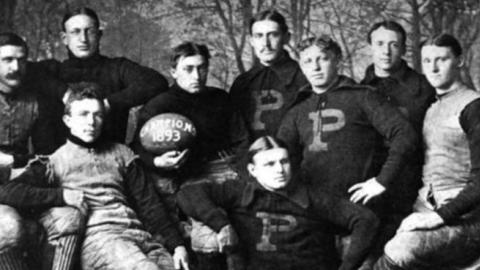Thanksgiving Day football can trace its origins back to the 1880s and a hugely popular annual game between Princeton and Yale in New York City.
Most New Yorkers seemed to take part in the festivities, whether or not they had tickets to the game. On Thanksgiving morning, fans pinned rosettes to their overcoats — blue for Yale, orange and black for Princeton — and paraded up and down Broadway. Shopkeepers decorated windows in the school colors. The wealthy hung banners displaying gigantic Y’s or P’s outside their mansions, while others flew bits of colored cloth out the windows of their apartments. The festivities were a spectacle, but in the words of a writer for Harper’s Weekly, the game was also the “greatest sporting event . . . this country has to show.”
By the early 1890s, 5,000 or more football games were being played across the country on Thanksgiving Day, and it was the No. 1 athletic event of the season at many colleges.
But not all Americans approved of the game. As Thanksgiving football fever swept the nation, it provoked a backlash from those who thought the emphasis on the sport detracted from the more important religious and familial aspects of the holiday.
The “true” meaning of Thanksgiving was hotly discussed from pulpits, in the newspapers and around dinner tables. Was Thanksgiving football a pernicious influence? Was its popularity intruding on family get-togethers and obscuring the religious obligation to give thanks to God and remember the less fortunate?
In 1893, the New York Herald lamented that “No longer is the day one of thanksgiving to the Giver of all good. The kicker now is king and the people bow down to him.” That same year the faculties of Princeton and Yale, worried that football distracted students from their studies and upset about the postgame brawls, announced that they were moving the game back to campus, where they could better control the football-crazy students.
The Chicago Tribune in 1896 published commentary on the meaning of the holiday. Prominent Chicagoans were asked to weigh in on the appropriate balance to be struck between God, football and family.
One clergyman warned of the encroachment of athletics on a day that properly belonged to home and family. Another clergyman disagreed, saying there was nothing wrong with a “family walk or spin on a wheel, the merry outdoor game, or even [a] more exciting football contest.”
It fell to a local rabbi — an obvious football fan — to provide the most eloquent response on the proper role of football on Thanksgiving Day: “A good God will delight in a joyful, manly people and accept the shout of victory won in manly contest as a thanksgiving offering,” he said. “There is a time for everything: a time to pray and a time to play.”

















